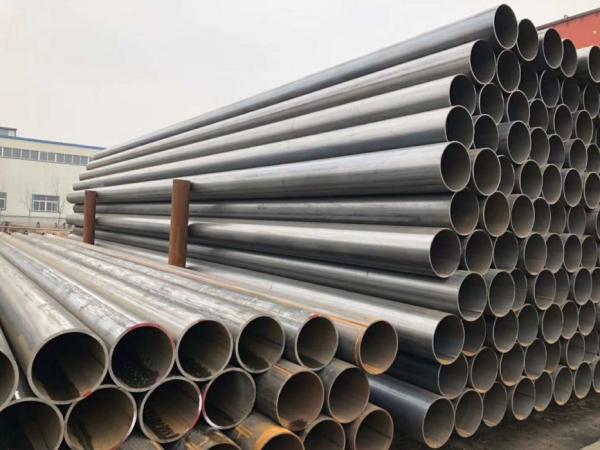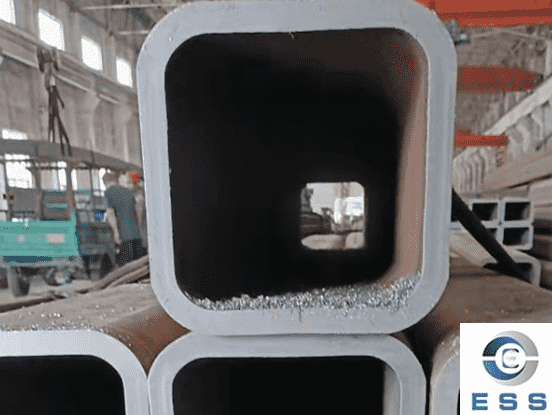A Comprehensive Guide to ERW Pipes
Electric Resistance Welding (ERW) is a widely used process for manufacturing steel pipes. ERW pipes are created by rolling a flat steel sheet into a cylindrical shape and then welding the edges together using electric current. ERW pipes are used in a wide range of industries, including oil and gas, construction, agriculture, and automotive. In this essay, we will provide a comprehensive guide to ERW pipes, including their manufacturing process, properties, advantages, disadvantages, and applications.

Manufacturing Process of ERW pipes
ERW pipes are manufactured by rolling a flat steel sheet into a cylindrical shape and then welding the edges together using electric current. The process involves passing an electric current through the edges of the steel sheet, heating the metal to its melting point, and then applying pressure to the metal to fuse the edges together. The resulting seam is then smoothed and the pipe is cut to the desired length.
The ERW process can be performed using either high-frequency induction or low-frequency induction. In high-frequency induction, the electric current is applied to the edges of the steel sheet at a high frequency, typically between 100kHz and 500kHz. This generates heat in the metal, which melts the edges together. In low-frequency induction, the electric current is applied to the edges of the steel sheet at a lower frequency, typically between 50Hz and 100kHz. This generates heat in the metal, which melts the edges together.
Properties of ERW pipes
ERW pipes have several properties that make them suitable for a wide range of applications. These properties include:
1.Strength and Durability: ERW pipes are strong and durable, as they are made from high-quality steel and are welded together using electric current. This makes them ideal for use in applications that require high strength and pressure resistance.
2.Uniformity: ERW pipes have a uniform wall thickness and diameter, which makes them ideal for use in applications that require consistent flow rates and pressure.
3.Cost-effectiveness: ERW pipes are less expensive to produce than seamless pipes, as they require less processing and finishing.
4.Weldability: ERW pipes are easily weldable, which makes them ideal for use in applications that require the joining of multiple pipes.
Advantages of ERW pipes
ERW pipes have several advantages over other types of pipes, including:
1.Cost-effectiveness: ERW pipes are less expensive to produce than seamless pipes, as they require less processing and finishing.
2.Availability: ERW pipes are readily available in a variety of sizes and shapes, making them suitable for a wide range of applications.
3.Weldability: ERW pipes are easily weldable, which makes them ideal for use in applications that require the joining of multiple pipes.
4.Uniformity: ERW pipes have a uniform wall thickness and diameter, which makes them ideal for use in applications that require consistent flow rates and pressure.
Disadvantages of ERW pipes
ERW pipes also have some disadvantages, including:
1.Limited wall thickness: ERW pipes are limited in terms of their wall thickness, which makes them less suitable for high-pressure applications.
2.Seam quality: The quality of the seam in ERW pipes can vary depending on the manufacturing process and the quality of the steel used. This can affect the durability and strength of the pipe.
3.Corrosion resistance: ERW pipes are more prone to corrosion than seamless pipes, as the weld seam can be a weak point in the pipe.
Applications of ERW pipes
ERW pipes are used in a wide range of applications, including:
1.Oil and gas pipelines: ERW pipes are commonly used in the oil and gas industry to transport petroleum products over long distances.
2.Construction: ERW pipes are used in construction to create structural components, such as columns and beams.
3.Agriculture: ERW pipes are used in agriculture to create fencing, irrigation systems, and other agricultural infrastructure.
4.Automotive: ERW pipes are used in the automotive industry to create exhaust systems and other components.
5.Plumbing: ERW pipes are used in plumbing to transport water and other fluids.
6.HVAC: ERW pipes are used in heating, ventilation, and air conditioning systems to transport air and other gases.
Conclusion
In conclusion, ERW pipes are a widely used type of steel pipe that are created using electric resistance welding. They are strong, durable, and cost-effective, and they have a uniform wall thickness and diameter that makes them suitable for a wide range of applications. While they have some disadvantages, such as limited wall thickness and seam quality, ERW pipes remain a popular choice for many industries, including oil and gas, construction, agriculture, automotive, plumbing, and HVAC. By understanding the manufacturing process, properties, advantages, disadvantages, and applications of ERW pipes, you can make an informed decision about whether they are the right choice for your project.













 Eastern Steel Manufacturing Co.,Ltd not only improve product production and sales services, but also provide additional value-added services. As long as you need, we can complete your specific needs together.
Eastern Steel Manufacturing Co.,Ltd not only improve product production and sales services, but also provide additional value-added services. As long as you need, we can complete your specific needs together.










